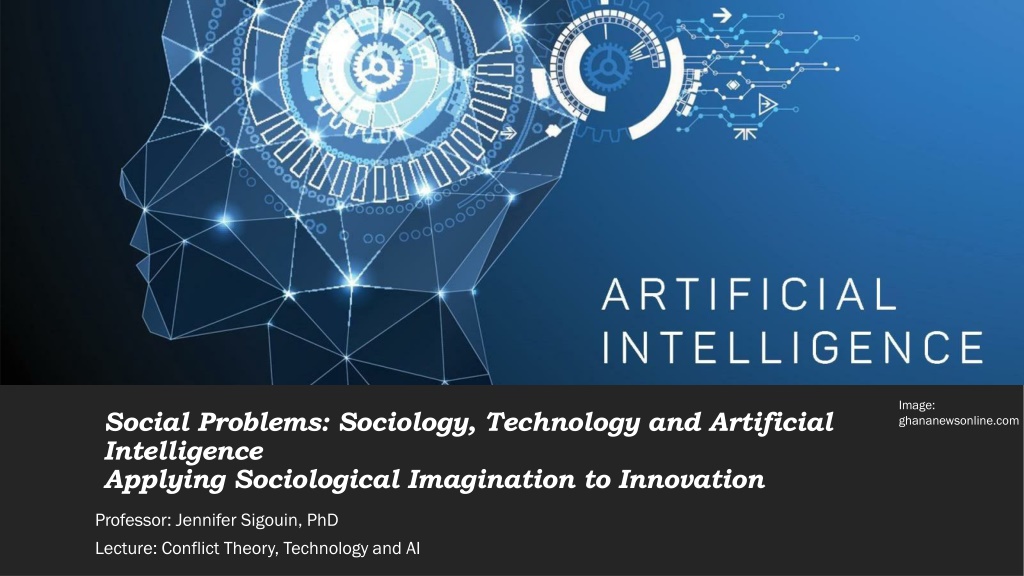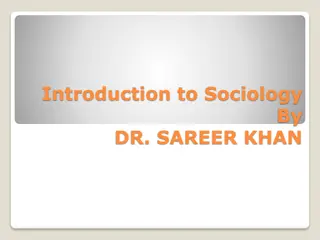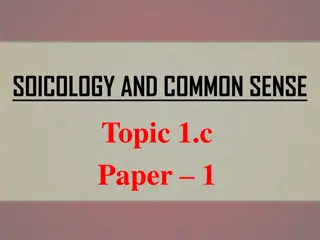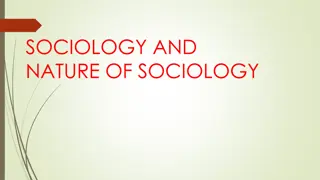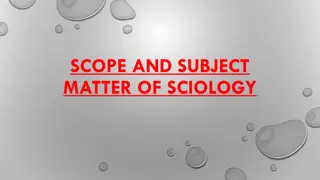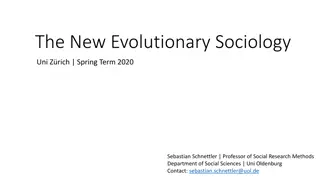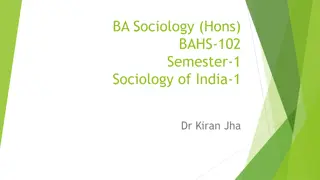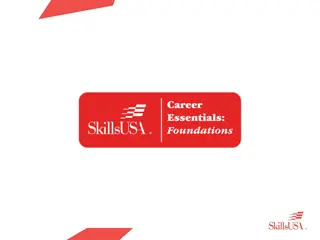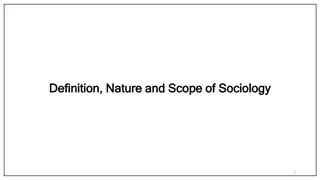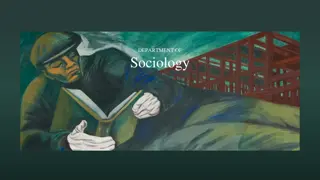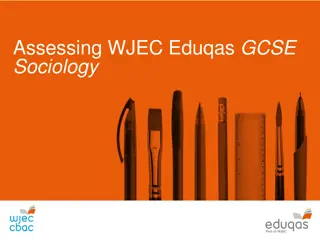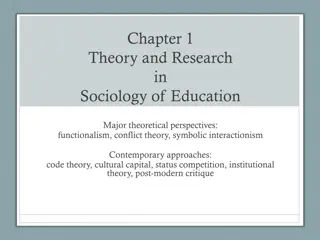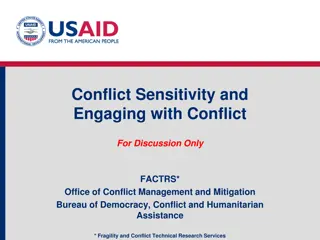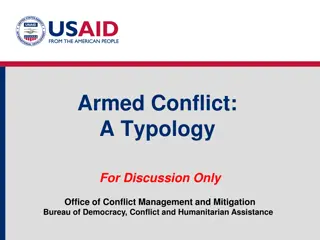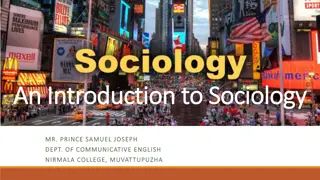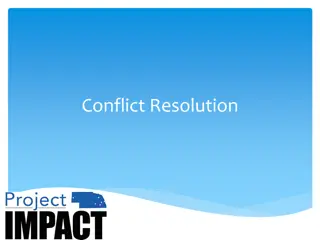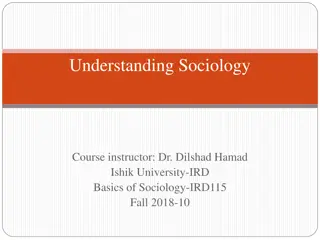Understanding Conflict Theory in Sociology: Impact of Technology and AI on Society
Conflict theory highlights societal inequality and competition for resources, with power unevenly distributed. The works of Marx and Engels on capitalism, exploitation, and alienation are discussed, along with the deskilling debate and the shift to a post-industrial knowledge economy. The lecture explores the intersection of sociology, technology, and artificial intelligence in shaping modern society.
Download Presentation

Please find below an Image/Link to download the presentation.
The content on the website is provided AS IS for your information and personal use only. It may not be sold, licensed, or shared on other websites without obtaining consent from the author. Download presentation by click this link. If you encounter any issues during the download, it is possible that the publisher has removed the file from their server.
E N D
Presentation Transcript
Image: ghananewsonline.com Social Problems: Sociology, Technology and Artificial Intelligence Applying Sociological Imagination to Innovation Professor: Jennifer Sigouin, PhD Lecture: Conflict Theory, Technology and AI
Outline What is Conflict theory The deskilling debate Surveillance Society The digital divide
Conflict Theory Argues that society is grounded upon inequality and competition over scarce resources. Two Basic Principles of Conflict Theory: Two Basic Principles of Conflict Theory: 1. Power is the core of all social relationships, and is scarce and unequally divided among members of society 2. The powerful promote their interests at the expense of the weak - They maintain their control through the dominant ideology - Inequality is the original evil. 1 - 3
Marx (1818 Marx (1818- -1883) and Engels (1820 1883) and Engels (1820- -1895) 1895) Work changed with capitalism so too did the means of production (e.g., technology) and the relations of production (workers vs owners) In a capitalist economy there are 3 classes that are diametrically opposed: 1. Bourgeoisie (owns the means of production) 2. Proletariat ( exchange labour for wage) 3. Petite bourgeoisie ( small business owners) predicted that it will disappear 1 - 4
Marx (1818 Marx (1818- -1883) and Engels (1820 1883) and Engels (1820- -1895) 1895) Two problems emerge in capitalism for the proletariat (worker): 1. Exploitation: a) Treating someone unfairly in order to benefit from their work; b) The difference between what workers are paid and the wealth they create. On January 4, 2021, Canada s top CEOs had already earned what most Canadians make in the entire year 2. Alienation: a condition of workers resulting from a lack of identity with the products of their labor, with their coworkers and society overall. Feeling of estrangement. 1 - 5
The deskilling debate Are we experiencing enskilling or deskilling ?
Daniel Bell (1973) The Coming of Post- Industrial Society Among the first to note that we had moved out of the industrial era, which impacted occupations Service-sector jobs will replace manufacturing. Knowledge workers (professionals, technicians, scientists) = greater power in the postindustrial economy. Knowledge economy Argued that knowledge is difficult to hoard, so expect less social inequality and reduced conflict in the future. 7
Braverman and Deskilling (Conflict theory) Deskilling= process of reducing the level of skills required to carry out a job, which can also lead to the workers losing skills they used to have Why: managers wanted to increase efficiency and have more control (same reasons as in factories). = Degradation and future class conflict (just one working class), lack of control/autonomy over work process BUT Deskilling a universal pattern for all workers in all occupations? 8
The Deskilling Debate Clement and Myles (1994): net increase in requirements to think on the job so overall conclusion: In North America and Western Europe= enskilling (increased skill requirements) education But: Increased polarization between skilled workers and those with less skills who experience deskilling (impact the working class, might accentuate class differences) 9
The Deskilling Debate Deskilling in some occupations/work settings (lower tier-services); restaurants, cleaning Multi-tasking (adding more tasks) versus multi-skilling (adding to the skill repertoire of workers) Need new studies Technology and AI: disappearance of certain jobs? (low-skilled, vulnerable groups) 10
Chapter 11 textbook by Anabel Quan-Haase entitled Technology and Society: Social Networks, Power, and Inequality THE SURVEILLANCE SOCIETY
Defining and Understanding Surveillance The term surveillance surveillance has French roots meaning watching over Surveillance by state and cies Eradication of privacy, diminishing of individual rights, and unnecessary obsession with data Data as free raw material for cies to anticipate needs and sell products, for government to anticipate and control behaviors Data as commodity Power and Control
The Snowden Case Edward Snowden, former contractor for the NSA, leaked classified material (thousands of top-secret documents about U.S. surveillance system) The Snowden files provided direct evidence of surveillance programs in place in the U.S. to monitor not only foreign leaders, but also US citizens Top-secret Prism program claims direct access to servers of firms including Google, Apple and Facebook. Big data is gathered via cellphone usage, social media and Internet activity allows officials to collect material including search history, the content of emails, file transfers and live chats, phone numbers and duration of calls, access to communication without warrants Whistleblower or traitor?
Why Disclose Personal Information Despite Privacy Concerns? Online users are not fully aware of their vulnerability to privacy threats - nothing to hide, nothing to fear Privacy becomes a concern only when it has been lost or breached
Why Disclose Personal Information Despite Privacy Concerns? cont d Voluntarily disclosing information known as information revelation revelation. information Privacy paradox: Privacy paradox: Users report high levels of concern about the potential misuse of their personal data but continue to disclose large amounts of personal information online. Solutions? Solutions?
Activity: I am my data I am asking you to pretend that you do not who you are..ha! Draw your profile based on the information you gather on the internet. What can someone or a company get to know about you based on an internet search? 1. Go on your Facebook profile, Parameters, your Facebook info. Request to have Facebook send you your Facebook 1. Go on your Facebook profile, Parameters, your Facebook info. Request to have Facebook send you your Facebook information. Do this now as it might take a day to receive the information. information. Do this now as it might take a day to receive the information. 2. Go on Google and search your name. Anything? You should log off of any account you might have (e.g. IG, Facebook). Search for your name on Facebook, Instagram, LinkedIn, etc.. Write down what one can know about you. 3. Look at the content that Facebook sent you. Look specifically at: ads and businesses- Your off Facebook activity, Advertisers_who_uploaded a contact list with your information, Ads interest Location: primary location Profile information So, what can one know about you based on an internet search? Provide a reflection on your findings.
Chapter 6 textbook by Anabel Quan-Haase entitled Technology and Society: Social Networks, Power, and Inequality TECHNOLOGY AND INEQUALITY
Why Study Technology and Inequality? Understanding technological inequality is important to researchers, policy-makers, and politicians because technology provides educational, political, and economic advantages, creating power imbalances power imbalances and potentially conflict conflict between social groups. Key issues to consider include the social, economic, and cultural consequences connected to the Internet. consequences for those not
The Digital Divide The digital divide digital divide describes the differences between social groups in access to, use of, and empowerment by networked computers and other digital tools. The gap between haves digital tools including cellphones, laptops, tablets, and e-book readers. haves and have have- -nots nots is also evident in a range of
Components of the Digital Divide Five central components of the digital divide : 1. 1. Access divide Access divide 2. 2. Skills divide Skills divide 3. 3. Economic opportunity divide Economic opportunity divide 4. 4. Democratic divide Democratic divide 5. 5. Social media divide Social media divide
1. Access Divide The access divide access divide examines: whether or not a person has access to the Internet type of access location frequency of use COVID is worsening the digital divide. According to the CRTC, nearly 86 per cent of households overall have that level of service currently, but in rural areas only 40 per cent do. In First Nation communities, it's estimated that just 30 per cent of households have internet connections with the recommended speed. (Stewart, CBC. 2020) Source: CRTC, https://crtc.gc.ca/eng/internet/internet.htm
Case Study: First Mile Project To improve connectivity, different strategies have been proposed to increase First Nations people s inclusion in the networked society. According to McMahon (2014), the First Mile project and other supports enable user communities to generate and sustain their own networked digital infrastructures (p. 4). First Mile project is an approach that focuses on ways that public policies, regulations, The First Mile project was developed from 2012 to 2013 and is now part of the First Nations Innovation project (https://fn- innovation-pn.com/first_mile.aspx) OCAP principles (refers to ownership, control, access and possession) are applied: First, that First Nations must retain access and possession of the capacity and resources to effectively manage the content, traffic and services on their local network. Second, that First Nations have a right to own and control the local broadband network in their communities in order to support the flow of information and services. (First Nations Innovation Project Website)
2. Skills Divide The skills divide skills divide is measured in terms of technical competence and information literacy in the digital world. Technical competence: Technical competence: knowledge about how to use computers Information literacy: Information literacy: ability to seek out information, evaluate it, and use it for specific purposes
3. Economic Opportunity Divide The economic opportunity divide economic opportunity divide reflects beliefs and attitudes that individuals have about the advantage provided by access to digital technologies. E.g., finding a job, obtaining health information, taking an online course
Dissecting racial bias in an algorithm used to manage the health of populations (Obermeyer et al., 2019) Conducted a study which found that an algorithm widely used in US hospitals to allocate health care to patients has been systematically discriminating against black people. Concluded that the algorithm was less likely to refer black people than white people who were equally sick to programmes that aim to improve care for patients with complex medical needs. Only 17.7% of patients that the algorithm assigned to receive extra care were black. The researchers calculated that the proportion would be 46.5% if the algorithm were unbiased. Algorithm based on total health care cost, but if practitioners are less likely to prescribe further tests to black people, then the algorithm reflects this systemic discrimination.
4. Democratic Divide The democratic divide democratic divide describes the use of the Internet for political engagement. E.g., researching political information, making donations to political entities, and communicating with the government, political participation, keeping people at the top accountable. E.g., Townhall Canada App
Ushahidi A global tech company born in Kenya during the 2008 election that empowers people to raise their voices Report any incidence of election tampering, violence Citizen engagement: increase interaction between people and their government Inclusive governance: marginalised groups have the chance to engage in governance processes Open and responsive government
5. Social Media Divide The social media divide social media divide is the gap that exists in adopting social networking sites social networking sites (SNS demographic variables such as gender, income, and education. SNSs) along Recently it has been posited that SNS usage is not a waste of time, but it is tied to identity management (can recreate oneself), informational access, and the creation of social and cultural capital.
Cultural Capital and Social Media Cultural capital Cultural capital describes the sum of intangible social assets that allow an individual to claim membership in specific social groups (Bourdieu, 1973). Cultural capital allows individuals to show credibility and belong to social groups. Knowing who to follow on Instagram, what music one needs to listen to, Netflix shows, latest gossip, etc is part of cultural capital, how to be in (e.g., caring for the environment).
Cultural Reproduction Theory: Social Capital The growth of social networks and relationships can result in a larger landscape of opportunity The presence or absence of social networks When applied to social media: # followers, #likes, YT: # of viewers, subscribers, can lead to income, career (influencers), can also provide friendship, support
